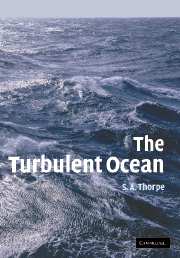Book contents
- Frontmatter
- Contents
- Preface
- Structure and résumé
- Acknowledgements
- 1 Heat, buoyancy, instability and turbulence
- 2 Neutral stability: internal waves
- 3 Instability and transition to turbulence in stratified shear flows
- 4 Convective instabilities
- 5 Instability and breaking of internal waves in mid-water
- 6 The measurement of turbulence and mixing
- 7 Fine-structure, transient-structures, and turbulence in the pycnocline
- 8 The benthic boundary layer
- 9 The upper ocean boundary layer
- 10 Shallow seas
- 11 Boundary layers on beaches and submarine slopes
- 12 Topographically related turbulence
- 13 Large-scale waves, eddies and dispersion
- 14 Epilogue
- Appendices
- References
- Index of laboratory experiments
- Subject index
- Plate section
10 - Shallow seas
Published online by Cambridge University Press: 05 June 2012
- Frontmatter
- Contents
- Preface
- Structure and résumé
- Acknowledgements
- 1 Heat, buoyancy, instability and turbulence
- 2 Neutral stability: internal waves
- 3 Instability and transition to turbulence in stratified shear flows
- 4 Convective instabilities
- 5 Instability and breaking of internal waves in mid-water
- 6 The measurement of turbulence and mixing
- 7 Fine-structure, transient-structures, and turbulence in the pycnocline
- 8 The benthic boundary layer
- 9 The upper ocean boundary layer
- 10 Shallow seas
- 11 Boundary layers on beaches and submarine slopes
- 12 Topographically related turbulence
- 13 Large-scale waves, eddies and dispersion
- 14 Epilogue
- Appendices
- References
- Index of laboratory experiments
- Subject index
- Plate section
Summary
Introduction
Many of the processes described in the preceding chapter also occur in the upper layers of shallow seas. Tidal flows are, however, generally more prominent, especially in the shelf seas, and the oscillatory motions induced by surface waves will, in some regions, affect the near-bed flow within the bottom boundary layer. (Waves are particularly effective in generating turbulence in shoaling water at the edge of the shallow seas, a topic deferred to Chapter 11.)
The bottom boundary layer in shallow seas shares with the benthic boundary layer (bbl) the physical characteristics described in Sections 8.2.1 and 8.2.3, but often has a substantial effect on the whole water column. It is far more accessible to observation than the bbl of the deep ocean described in Chapter 8 and, because of its importance, for example in the transport of sediment and the movement of sandbanks and channels, its study is one of considerable practical application.
Some 2.6 TW of tidal energy are dissipated in the bottom boundary layers of shallow seas. The first estimation of the importance of boundary dissipation, and indeed of ε in the ocean, was by Taylor (1919). He made two independent determinations of tidal dissipation during Spring tides in the Irish Sea. The first was made by finding the averaged product of the bottom stress, ρ0CDU2, and the tidal current, U, integrating over the area of the Sea and making use of the value, 2 × 10−3, of the drag coefficient, CD, that he had derived from measurements of the atmospheric boundary layer on Salisbury Plain, UK (Taylor, 1916).
Information
- Type
- Chapter
- Information
- The Turbulent Ocean , pp. 269 - 290Publisher: Cambridge University PressPrint publication year: 2005
